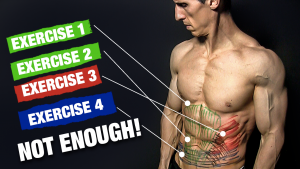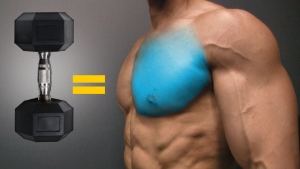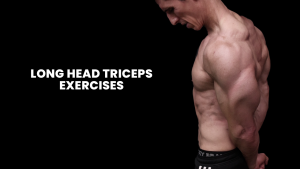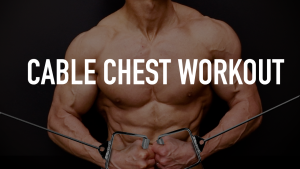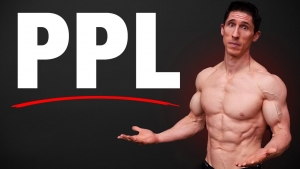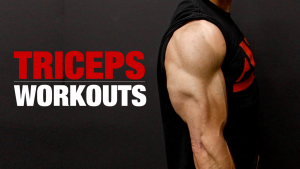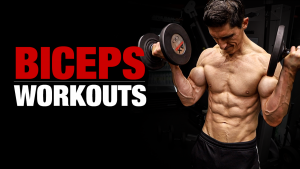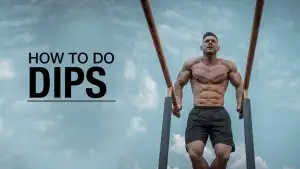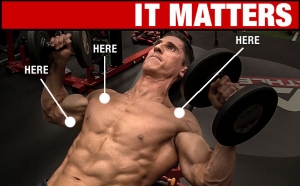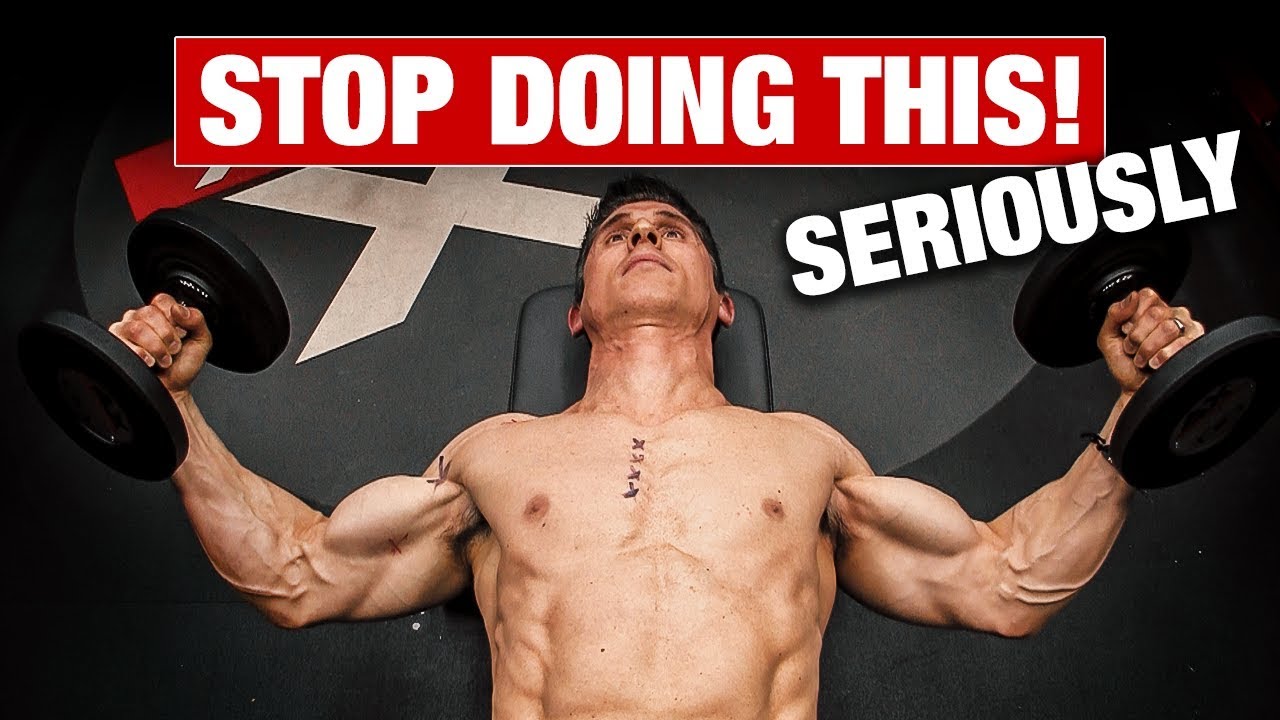
STOP DOING CHEST FLYS
Are you still doing Flys on Chest Day?
It’s no surprise that chest flies are not in my “absolute go-to chest exercises” category.
As I’ve talked about many times, I believe that the risk-reward ratio is all risk and no reward.
“But Jeff, what’s the big deal with chest flies? Are they THAT bad for training your chest?”
Guys, it’s important to remember what I do. I need to teach professionals how to exercise so they can be better at their sport.
Imagine if you’re a pro quarterback and you hurt your shoulder joint or shoulder blades during chest exercises that I recommended. Not only are you out for several games, but you’re going to be pissed at me!
Pro athlete or not, I don’t want this to happen to you either. I’m actually surprised at how many fitness experts and fitness enthusiasts like this exercise.
That’s why I’m going to breakdown everything that is wrong with the Dumbbell Fly (Chest Fly). But I’m also going to show you alternatives that are more effective AND far safer.
Let’s get to it!
ANATOMY OF THE CHEST
Before I jump into effective chest exercises for your chest workout, I want to review the chest muscles.
You probably know that what you typically refer to as your “chest muscles” is called the pectoralis major. It’s also called the pec major or pecs.
The superficial part of the chest is a singular muscle, and not comprised of three separate pectoralis muscles as many people would suggest.
You also have the pectoralis minor, but this is a deep muscle found beneath the pectoralis major muscle. For this article, I’m going to focus on the pec major.
The pectoralis major muscle fibers run three different ways, and this is the reason that the chest is usually referred to in three distinct sections.
The clavicle and sternum bones provide origin points for the chest muscles.
UPPER CHEST FIBERS


The fibres in the upper chest begin at the clavicular head near the shoulders and descend toward the humerus, where they connect diagonally upward from the center of the chest.
MID CHEST FIBERS


The sternum is the start point for the mid chest muscle fibers, which extend horizontally across the chest.
LOWER CHEST FIBERS

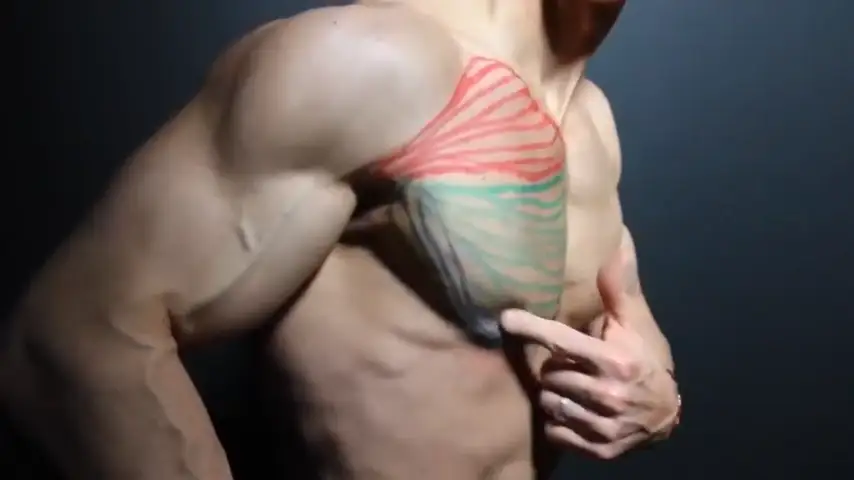
The lower chest fibers start at the base of the sternum, then travel diagonally down and inward toward the center of the chest.
4 REASONS TO STOP DOING CHEST FLIES
Here are four reasons why I think it’s in your best interest to stop doing Chest Flies on a bench.
To illustrate this, I’m going to demonstrate the Chest Fly movement pattern, and I’ll be doing so with a traditional Flat Bench Dumbbell Fly. I think you’ll be surprised at just how unsafe this exercise can be.
Speaking of safety…
1) IT’S NOT SAFE
The form, posture, and execution of the Dumbbell Fly exercise puts you in a vulnerable position with a huge emphasis on the entire shoulder complex.
And I’m not even talking about common mistakes here. I’m talking about the exercise itself.
You might remember when I talked about doing Chest Flyes on the floor.
While I think there are better exercises for building an impressive chest, I do support people who need to be doing some type of Dumbbell Fly.
When you have a floor to support you, then you don’t have to worry about the potential detrimental effects.
If you’re on a bench, you’ll have nothing to support you when it matters most.

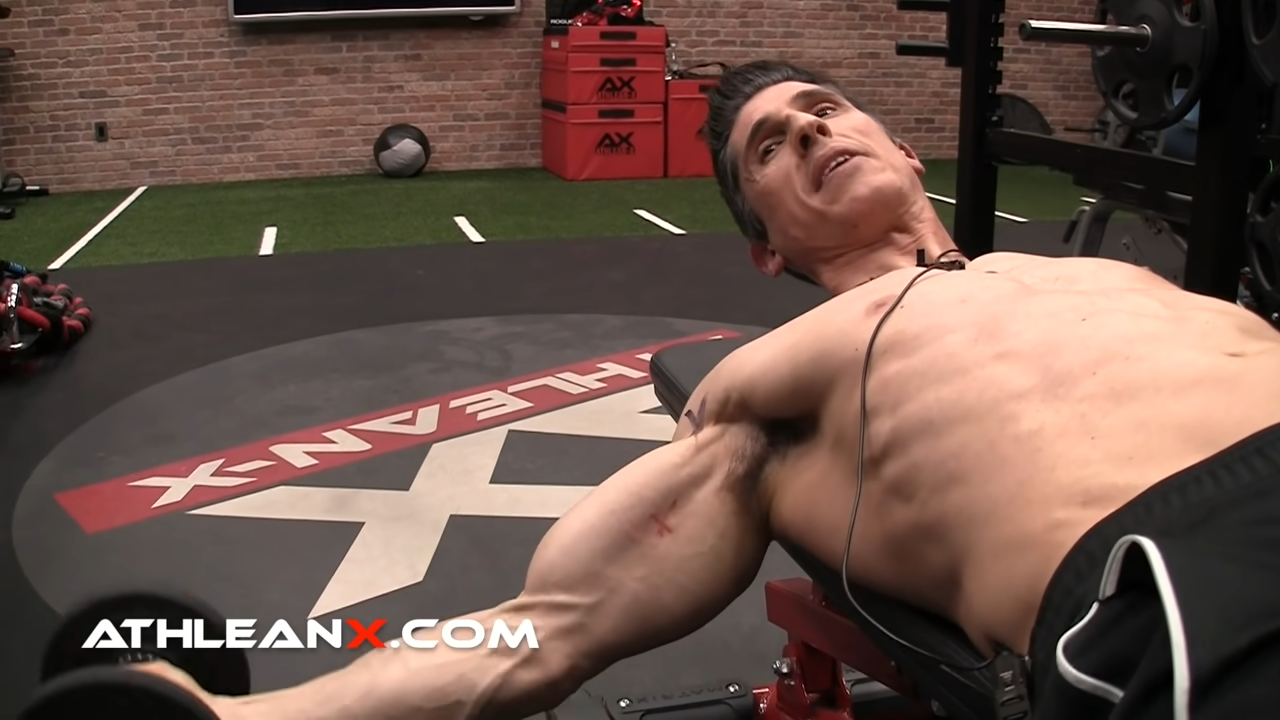
When the weight is that far away from your body, the risk for shoulder injury and overextension goes through the roof.
On a bench, there’s simply no protection against this overextension. And it doesn’t matter if you are using a flat bench, an incline bench or what bench angle you’re using.
Even if you’re using lighter weights to account for the fact that you’re weaker at this angle, you can still cause excess stress to the front of the shoulder.
In particular, you will damage the anterior shoulder capsule, and that’s something you don’t want to mess with.
2) YOU CAN’T GO HEAVY
Think about how heavy a weight feels when you’re performing Chest Presses and you lower the weight to the chest level.
Now, imagine that much weight at chest level but extended all the way out to your sides. Impossible, right?
And that’s the point. Since a Dumbbell Fly feels heavier at the peak of the extension, you can’t use a lot of weight safely.
It doesn’t matter if there’s a slight bend in your elbow, there’s still a ton of stress on the chest muscles and connective tissue, but not where you think it is.
The effect on the pectoral muscles becomes more intense and not in a good way, because the pec can’t apply the same amount of force.
Think of it like this: the further the distance of the dumbbell from your body, the heavier it’s going to feel even if you’re using light weights.
What does it matter if you can’t use heavy weights?
If you want to get stronger, develop your chest, or increase muscle growth, you’re going to need to go heavy. If you’re using a chest strength training exercise that isn’t safe and doesn’t allow you to go heavy, you’re wasting your time.
3) LITTLE FORCE / RESISTANCE WHEN IT COUNTS
When you’re at the top of an exercise, you should be fighting against the resistance of the dumbbell weight. For example, during a Barbell Bench Press variation, when the barbell is at the top of the movement, you are still fighting to keep it up and stable.
With a Chest Dumbbell Fly, that’s not the case. At the very top of this exercise, you have straight arms above your chest.
It might look like you’re doing a lot, but you’re applying very little, if any force at all, to the pec muscle, which means very little chest activation.
Sure, I feel something when I extend the dumbbells to chest level, but I feel like I could sit in that neutral position for hours and not get tired.
This is an issue because this is where we want the pec in its peak contracted state or close to it. The idea is to get the pectoral muscles into full chest adduction, but you won’t be able to do that with the bench Dumbbell Chest Fly exercise.
No chest squeeze? Don’t expect results.
This also goes back to the idea of muscle growth. If that’s your goal, you need constant tension on the muscle. Unfortunately, Chest Flys just won’t deliver that, which means you’re cheating yourself on Chest Day.
If you want a massive chest, you won’t get one with Chest Flys.
4) YOU’RE NOT STRETCHING THE MUSCLE
Finally, a lot of people talk about how much they like Chest Flies as a part of their chest day routine because of the supposed stretch on the pec muscle.
But those people are confusing it for a stretch on a different muscle.
We know when we get to the bottom of Barbell Bench Presses, there is a direct effect on the sternum and upper humerus.
You can feel those attachment points.
Now, from this difficult position, if I were to increase the length of my arms by opening up my elbows, the amount of extra stretch on the chest is almost absent.

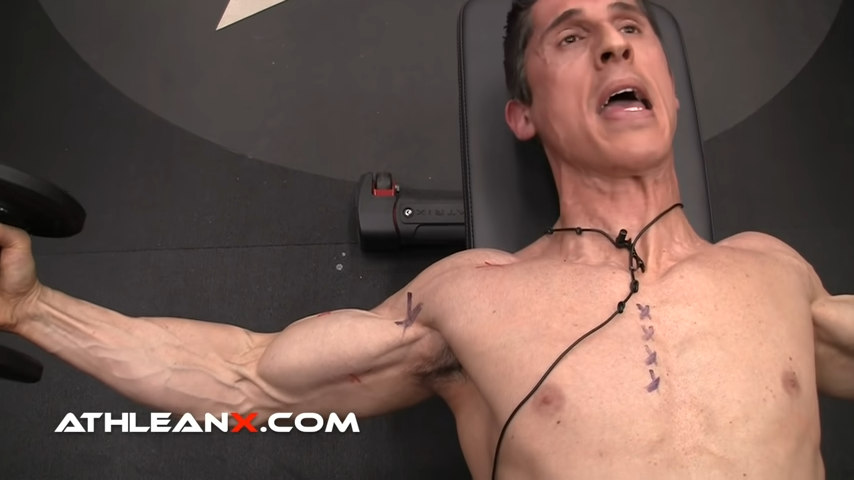
If anything, it’s extremely minimal. Even if I brought my arm down a little bit, it’s still very minimal.
What you are mistaking for a stretch on the pec is actually a stretch on the extra cartilage in the ribcage. You’ll also feel it in your arm, but again, this is a different muscle called the coracobrachialis.
That muscle starts deep inside the shoulder, and it runs outside, further down on that same humerus. You can see a little piece of it underneath the bicep.
To recap, for those that are arguing, “I feel a lot of extra stretch here,” it’s not really what you’re feeling.
We know that there are better alternatives for that extra stretch on the pec.
For example, you can go to a bottom portion of a Dip to get a better stretch on the pec than you can with Chest Flies.
DO THIS INSTEAD: SINGLE-ARM CABLE CROSSOVER
So, what’s the better alternative? I told you I wouldn’t leave you hanging.
I’ve gone to this cable machine exercise plenty of times for a reason. It’s a better and safer alternative to the Dumbbell Fly that allows you to achieve a focused contraction.

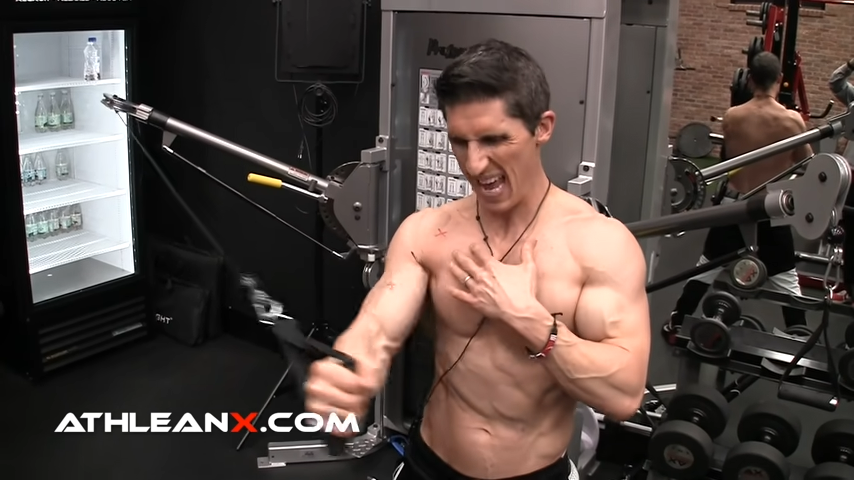
Here’s why I recommend the Cable Fly or Single-Arm Cable Crossover instead of the Bench Fly.
FULL ACTIVATION
Remember, Cable Chest Fly machine exercise isn’t locked into being performed on a bench with your arms out to your side.
The cable machine version focuses on taking your arm through a full range of motion for horizontal adduction, realizing that’s the primary function of the chest.
It’s all about full contraction and that’s exactly what this popular chest exercise can deliver.
If you can get the resistance across midline at peak pectoral contraction, then you’re doing exactly what you need to do.
It also fully activates the core as you twist the body to get the arm across your midline, which is a great extra challenge.
And you can do that with a Cable Machine Fly. Or if you don’t have those types of equipment, you can anchor a band to anything and do the same thing.
Resistance bands are great for at-home chest development, so you should invest in a pair regardless of your gym membership status.
YOU CAN GO HEAVIER… SAFELY
The starting position of the Single-Arm Cable Fly or Band Chest Fly ensures the least amount of force is being applied at the weakest position of this upper body exercise.
That’s good because now I’m not stuck using only lighter weights. I can use the heavier weight without any safety issues like you’d get with a Dumbbell Fly.
I have peak force applied here to the pec because of the varying line of resistance of the cable. And it’s in this peak contracted state that the pecs are doing the most work. This is great no matter your fitness goal.
At the same time, I’m not concerned about the extra stretch because it’s targeting the proper muscle.
RESISTANCE AT THE TOP (AND THROUGHOUT)
One of my favorite things about the Single-Arm Cable Crossover is that you will have resistance at the top of the exercise the entire time.
Again, think back to the Chest Fly variation. There was nothing at the top.
With a Cable Machine Fly, you can continue to fight through the resistance across your midline, which you should do throughout the entire movement.
This is going to have a much more significant impact on the chest.
HONORABLE MENTION: THE FLOOR FLY
Let’s say you just can’t forget about the Chest Fly. Maybe it’s one of your favorite exercises and to remove it altogether would crush your Chest Day workout.
In that case, I’d say, “Okay, but instead of the Bench Dumbbell Fly, I want you to opt for the Floor Fly.”
By doing it on the floor with proper form, what we’re able to do is get in the same stable position, almost simulate the same amount of depth because we can arch the low back here this way.
Keep the butt in contact with the ground and the shoulder blades pinched together (shoulder retraction). Make sure the elbows are bent. Keep up this correct form throughout the entire motion.


Doing this on the floor, we’ve got a safety net underneath us. This allows us to dump the weights if we need to without the same risk for injury to the front side of the shoulder, or the pec itself.
For those of you who want to gain more muscle, you want to be able to overload the muscle, right? But if you’ve been avoiding the heavier weights because it’s not a good idea on Chest Flies, you’ve been missing out.
With the Floor Fly, you can go heavy. With the floor beneath, you can focus on doing eccentric overloading, and you can do this safely knowing there’s a safety net below you.
Guys, it’s time to bury the unsupported Chest Fly. And no, I’m not referring to common Dumbbell Fly mistakes. I’m talking about the Chest Fly itself.
I know a lot of guys want to do it, but if you really want to see improvements on your chest development, you need to include more adduction in your current chest training regimen.
Make sure you’re achieving that adduction with a cable or resistance band and I promise that you’ll get better results.
If you’re looking for a strength training program that will help you progress your strength and build muscle mass, you’ve come to the right place. Check out the links below to see which of our ATHLEAN-X programs best fits your goals. We’ve got programs for beginner strength training, advanced lifters and everything in between!

- The Chest Fly is not the exercise you want to be doing if you’re serious about chest growth and development. Here’s why:
- First, look at the position of the shoulder region and the risk to the joint when performing the Dumbbell Chest Fly unsupported on a bench. With your arms held out to the sides, there is no protection against hyperextension of the shoulder with fatigue. Should you fail, you’re going to tear up your shoulders especially the anterior capsule of your shoulders.
- Next, to accommodate the weakness in this position, you need to lighten the weights significantly. This provides less of a mechanical overload to the pecs.
- Also, the stretch that people argue they feel more intensely with a Dumbbell Chest Fly is not really something that exists. What you are feeling is not a stretch in the pecs but rather a more intense stretch in the coracobrachialis muscle.
- So, what can you do instead? I recommend the Standing Crossover Fly. With this exercise, you have the least amount of tension on the pecs when they are at their weakest and the most tension on them when they are at their strongest.
- The cable standing version done with a weight machine also allows you to match the weight better to your strength curve and provide more of an overload while eliminating almost all of the risk to the shoulder that is common with the dumbbell variation.
- If you can’t stand to part with the fly exercise, consider a Floor Fly instead. The Floor Fly variation provides you with the floor to prevent unwanted joint stress and give you a safety net should a weight fall.
REFERENCES

Jeff Cavaliere M.S.P.T, CSCS
Jeff Cavaliere is a Physical Therapist, Strength Coach and creator of the ATHLEAN-X Training Programs and ATHLEAN-Rx Supplements. He has a Masters in Physical Therapy (MSPT) and has worked as Head Physical Therapist for the New York Mets, as well as training many elite professional athletes in Major League Baseball, NFL, MMA and professional wrestling. His programs produce “next level” achievements in muscle size, strength and performance for professional athletes and anyone looking to build a muscular athletic physique.



